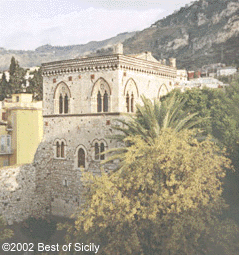...Best of Sicily presents... Best of Sicily Magazine. ... Dedicated to Sicilian art, culture, history, people, places and all things Sicilian. |
by Carlo Trabia | ||
Magazine Index Best of Sicily Arts & Culture Fashion Food & Wine History & Society About Us Travel Faqs Contact Map of Sicily |
Many, if not most, Sicilian buildings erected during this era had arched windows of this kind, with either one or two "lights." Over the centuries, the "Gothic" windows, and many entire buildings, were modified or rebuilt, but these aesthetic features are still to be seen in Sicily --often on otherwise anonymous medieval walls hidden in narrow historical streets. Indeed, a number of buildings to be seen in Taormina boast arched portals and windows, though few are as well preserved as Palazzo Santo Stefano, now the property of the city of Taormina and occasionally used for public meetings and even civil weddings. Considered in the architectural context of its late medieval modifications, Palazzo Santo Stefano is an aristocratic Sicilian home typical of its era, when traditional castles were becoming less practical and the feudal nobility was making its first migratory movements toward the larger cities. Taormina was a "desmenial," rather than a "feudal" city. That meant that its feudal rights (taxes, etc.) appertained to the crown directly, and not to a particular feudal lord. The De Spucches were one of many noble families resident in Taormina. With its vaulted ceilings and other medieval characteristics, Palazzo Santo Stefano, if not a castle in the truest sense, certainly reflects the spirit of Sicily's feudal past. Located just within the city walls, it is dwarfed by hotels and other modern structures, but until the eightteenth century it was still one of the higher buildings in the old district of Taormina. When it was constructed, this splendid home offered a grandiose view of the coast far below and Mount Etna in the distance. In medieval Italy's mercantile cities, the height of a family's residence was intended to reflect its social importance and wealth. This development reached its height (excuse the pun) in northern city states such as Mantua, but Taormina witnessed its own manifestation of the trend. Fit for a baron, or at least a loyal knight, Palazzo Santo Stefano is one of the few such homes still standing in Taormina. It's not the only medieval structure in this part of Taormina. The city walls and the "duomo" (the main church) are just a few steps away. Most of Taormina's historical district is built upon the ancient Greek and Roman city, and these medieval buildings are no exception. In a place like Taormina, Palazzo Santo Stefano's seven century history, though impressive, seems like yesterday. About the Author: Architect Carlo Trabia has written for various magazines and professional journals, as well as this online magazine. | |
Top of Page |
 It stands in what seems like an isolated part of Taormina, a castle built in Sicily's twelfth century Norman Arab style but with subsequent additions. Heraldic history tells us that the De Spucches family arrived in Sicily with Peter of Aragon following the War of the Vespers in the thirteenth century. The fief of Santo Stefano was one of many territories possessed by this family, and lent its name to the fortified dwelling, not quite a castle, which bears that name today. As we have said, the older part of Palazzo Santo Stefano, the lower level below the stringcourse, is Norman Arab. The upper floor, added later, retains a rather similar medieval style, with slightly different Moorish details such as the multicolour stone motif and, of course, splendid arched windows. You don't have to be an architect to notice the subtly contrasting, but perfectly complementary, styles of the building above and below the stringcourse, which was initially the level of the roof.
It stands in what seems like an isolated part of Taormina, a castle built in Sicily's twelfth century Norman Arab style but with subsequent additions. Heraldic history tells us that the De Spucches family arrived in Sicily with Peter of Aragon following the War of the Vespers in the thirteenth century. The fief of Santo Stefano was one of many territories possessed by this family, and lent its name to the fortified dwelling, not quite a castle, which bears that name today. As we have said, the older part of Palazzo Santo Stefano, the lower level below the stringcourse, is Norman Arab. The upper floor, added later, retains a rather similar medieval style, with slightly different Moorish details such as the multicolour stone motif and, of course, splendid arched windows. You don't have to be an architect to notice the subtly contrasting, but perfectly complementary, styles of the building above and below the stringcourse, which was initially the level of the roof.